Organic and Green Savings: Gardening Edition!
The next Green Moms’ Carnival, to be hosted on Monday, by the lovely Anna of Green-Talk, is all about gardening. Last spring, inspired by Anna and her great gardening posts I decided to try raising plants from seed for the first time. It was fun in the beginning.
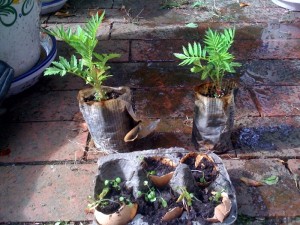
But unfortunately the plants never took.
Fact is, I’m not much for gardening. I can’t even keep an “indestructible” bamboo plant alive on my desk.
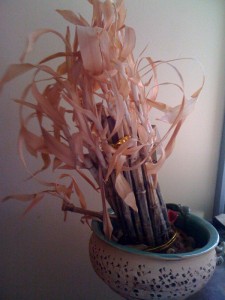
The only plants that survive in my garden are the really natural ones – you know, the ones that come up no matter what you do. (And the ones that our house’s former owner, a Master Gardener, planted and left for us!)
So my bad luck with gardening presented a dilemma for this carnival. What to write? What could I possibly contribute?
For the past few years, I’ve blogged on a semi-regular basis about organic and green savings. Most of the time I’ve focused on food. Never on gardening. So here you go – if I can’t pass along sage gardening advice, at least I can pass along a few tips on good gardening values.
Organic Gardening Soil & Other Organic Accoutrements
In the past few years, the organic gardening trend has really taken off. And frankly, it’s puzzled me a bit. For unless you live on soil that was previously treated with chemicals, herbicides and pesticides, odds are your soil is already organic! There’s no need for fancy “organic” soils and supplies. Save your money for more important organic supplies…plants and seeds.
Which Organic Seeds? Which Organic Plants?
It’s pretty cool to find all of the grocery stores stocking seed these days – even organic seed. But there’s a price differential – as with most things organic. At the local Giant and Safeway grocery stores in Bethesda, Maryland, you’ll pay .90 cents more per packet for organic seed versus conventional. Funny how it seems like a lot of money at the time – until you think of how much produce those seeds should yield!
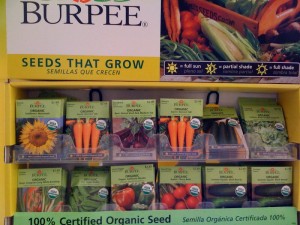
What are you really buying? For the home gardener, the most important thing about organic seed is that it guarantees that the plants you are growing will not be from genetically modified stock. So which plants are most likely to be genetically modified? In the US, the vast majority of corn, soy, and tomato crops are genetically modified. Concerns have been raised about what the ramifications may be of ingesting GMOs – a practice that has been banned in Japan and the EU. There may be some genetic modification of other crops, but it’s not as common as with corn, soy and tomato – so those are the plants and seedlings you should definitely buy organic. By all means, buy everything organic if you can – just to be on the safe side. But if not, spring for the big 3: tomatoes, corn and soy.
Gardening is Not Necessarily Green
One of the biggest lessons I’ve learned on this blogging journey is this: organic does not necessarily mean green. Green does not necessarily mean organic. Organic doesn’t mean fair trade. And the list goes on…..
Same with gardening. If you’re trying to live a more sustainable lifestyle, does buying plants in plastic containers make sense?
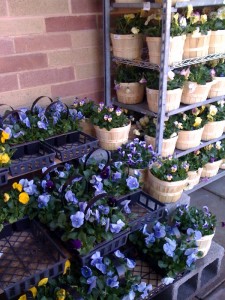
Not only is plastic made from petrochemicals (increasing our carbon footprints and contributing to global warming), but it doesn’t degrade in a landfill or compost heap. The manufacturing process is also highly toxic, often causing health problems for the people unfortunate enough to live nearby the manufacturing facilities. (For more on this, watch Tapped, The Movie).
Sometimes, the choice is easy, like it was at this Giant store. A wooden basket or plastic? For the same price? What an easy choice.
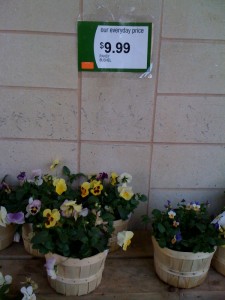
Other times, you may think you have no choice – just row after row of plastic seedling containers.
But there’s always a better way. Cardboard, egg crate, and other paper-based materials can all be re-used (and later composted) to make seedling pots.
Talk to your store’s manager. Ask if they can talk to their suppliers about more sustainable packaging. Even if they can’t change the packaging, surely they can start a take-back program for the little plastic pots. Write a letter. Ask your friends to do the same. You’d be amazed at what a little bit of consumer input can do!
Garden. Do it Organically or Not. But be Green. Don’t contribute more to the plastic waste stream in your quest to “be green” by planting a bit of garden space in your backyard.
For more tips on gardening, head on over to Green-Talk to hear what the rest of the Green Moms Carnival members have to say about gardening. And for more tips on living life with less plastic, check out Fake Plastic Fish.
— Lynn
Copyright OrganicMania 2010
Filed under Bethesda, Giant, Organic Prices, Product Recommendations, Savings Tips | Wordpress Comments (5) | My StumbleUpon Page
My StumbleUpon Page



